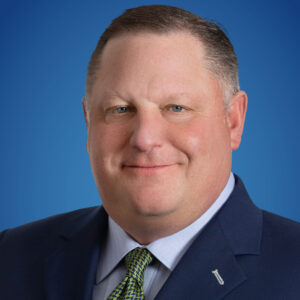QBE North America’s commercial insurance business is poised to mark a major milestone in a digital transformation of its underwriting operations.
The carrier’s underwriters have been involved in a proof-of-concept for an underwriting platform from technology provider Federato, which is being customized to QBE NA’s needs. The platform—a focal point of a business-led transformation at QBE NA—is now set to be rolled out to the middle-market underwriting team.
Carrier Management recently interviewed Federato leaders for the inside scoop on what their RiskOps platform is all about. (Related article: “1,200 Interviews and Counting: How Federato Is Solving Underwriters’ Problems—and Lowering Carrier Reinsurance Costs“) Separately, we interviewed Tom Fitzgerald, president of Commercial Insurance at QBE NA, and Greg Puleo, vice president, Digital Transformation, to get the carrier side of the story of what’s changing for QBE NA and how the underwriting transformation is being accomplished.
(Editor’s Note: Carrier Management interviewed Fitzgerald and Puleo in November 2022. In January 2023. Fitzgerald left QBE NA to join World Insurance Associates, LLC in a new role as president of World’s retail business.)
Q: When did the transformation begin, and what were some of the goals at the outset?
Fitzgerald: I don’t really think there’s a start and an endpoint. You continue to look for ways to drive efficiencies and process improvement into your organization each and every day.
QBE has been on a journey to simplify the day in the life of an underwriter and bring tools that can allow them to access broad swaths of information efficiently and effectively in the process of underwriting a particular insured….
As we think about what the next five years holds for us, we look out and we see great opportunities to continue to simplify how data is provided, how underwriters can consume it, and then how it can ultimately help inform decision-making at the desk level. [But] this is not a start and a stop. [It’s] a journey that continues with markers along the way that allow us to continue to focus on simplification, efficiency and underwriting profitability…
Puleo: For us, it was really about understanding the current state where underwriters were living today…What data elements do they need to make decisions? What else do they pull together as part of that process? How do they interact with their broker partners? [From there], we built out an exhaustive list of capabilities that our future-state solutions needed to fulfill…We pulled together some wireframes and visionary documents around how we could bring those together, centered around the concept of an underwriting workbench—[to give] underwriters access to all of those things in one place, whether it was third-party data, data we had in our internal systems, tools or AI models. [And we wanted them to] see it in an intuitive fashion…, right there at the time of decisioning, so they could spend their time focused on customer conversations, evaluating risks, making good decisions versus finding the right Excel sheet or going to the right website.
 “Given the fact that we’re putting out tens of millions of dollars’ worth of limit, one account with a better risk decision-making framework can pay for tools in IT transformation for decades.”
“Given the fact that we’re putting out tens of millions of dollars’ worth of limit, one account with a better risk decision-making framework can pay for tools in IT transformation for decades.”
Tom Fitzgerald, QBE NA
Fitzgerald: A lot of our transformation has been business led. That’s an important piece of the puzzle here. It’s not a bunch of technology folks making decisions in a vacuum. They were literally working with the business to help be thoughtful about the processes and the infrastructure that we put into place to support the business.
Q: Describe the underwriting process prior to engaging Federato. What underwriting pain points is the transformation addressing?
Puleo: Our underwriting process starts with an email. [Underwriters] get an email from an agent or a broker…It’ll have some cover language and then a handful of attachments: maybe a schedule of vehicles, a listing of properties, a list of employees…They would take that schedule of vehicles and key it into an Excel sheet on our side, and then do some pricing modeling there. They’d key that into a policy admin system. We were running a fairly older mainframe-based system, so they’d have to key it into that and get some details out of there. They’d pull two or three different data sources, whether that’s a PDF report from CoreLogic or whether that’s a download from ISO.
Then they would run it through some additional tools on our side, and they’d take all of that and, ultimately, they would make a risk decision [to deliver a] quote.
They send that out as a manual document the broker would get. They’d go back and forth in some negotiations. Ultimately, you get to a bind decision…
So, that was our current stat—highly manual, a lot of different tools that an underwriter had to go to. [When] we counted it up, there were probably 13 or 14 different things an underwriter would have to interact with to make that decision. A lot of key entry, either by underwriters, underwriting assistants or processing teams. And a lot of things that were stitched together by people in those various roles.
Fitzgerald: One of the other observations we had was that depending upon the underwriter, depending upon the level of experience, depending upon their understanding of how QBE does it, what we found is a lack of uniformity…The process by which they got to the outcome and the things that they evaluated throughout the process—third-party data, internal data, other elements that helped them make risk decisions—were not consistent across the platform…Uniformity matters. What is the best practice that we can have at the underwriting desk and then just replicate ad nauseam. As Greg speaks about the future state of where we intend to land, you’ll get a sense that not only do we drive efficiencies, we drive uniformity.
Q: Talk about the progress QBE NA has made in addressing these problems.
Puleo: Where we’ll be very, very quickly landing is a modern underwriting workbench. With Federato, we’ve done a proof of concept…
In today’s world, documents will come in, they will be automatically ingested; Excel sheets or PDF documents will automatically be converted into a format that can be machine readable and pushed into the data store. [The] underwriter then sees all of their accounts and all of that first-party and third-party data in one spot, either enabled through API connections to third-party data sources like D&B or ISO or CoreLogic, or through internal connections to our data store that has all the policy-level information and all the claim-level information.
So, within this single pane of glass, underwriters now have all the detail they need. And we didn’t have to have people key those things in along the way. [And we] can start to enforce some of that uniformity. [Underwriters] see the same third-party data elements. They see the same internal data. They have to go through a referral process based on account size or premium volume. They have to go through certain checks based on enforced workflow. All of that is now enabled because it’s within the single system.
Q: What type of technology did you seek for the transformation? Why did QBE NA choose Federato?
Puleo: The underwriting workbench was the start because if you can’t get your underwriters into a single platform and onto that single pane of glass, you don’t get to reap the benefits of the portfolio management, the integration of AI models to look at propensity to buy or renewal…
 “For me, the measure of success is probably when the platform fades into the background and the underwriters can focus on making good risk decisions and interacting with their agents or brokers.”
“For me, the measure of success is probably when the platform fades into the background and the underwriters can focus on making good risk decisions and interacting with their agents or brokers.”
Greg Puleo, QBE NA
And so, we looked at it as a journey. Step 1 is get everybody onto this single platform that leverages data, that leverages the API connections. Then we can unlock the power of all of that and really start to get to that next level.
Fitzgerald: From a business perspective, we weren’t looking for a vendor. We were looking for a partner. We were looking for somebody who could ultimately come in and understand the myriad needs that we had, and had the flexibility and the agility to come along on a journey with us…
Federato’s team really put a tremendous amount of effort behind learning QBE before they began to whip up the solution. And that’s exactly what we were looking for because we had a vision, which is clearly not an off-the-shelf product that we could go out and buy. This concept of partnership and the agility that they brought to the way Greg and the team would engage with them was very, very high on our list.
Q: What are some of the things that maybe a carrier should focus on when they’re looking to choose an underwriting technology partner?
Puleo: We have some pretty aggressive goals that we’re looking to meet as an organization. Being able to get a solution up and running in months, not quarters or years, was very important…
Fitzgerald: [Also], senior-level commitment and senior-level involvement. I don’t know how many times [Federato CEO] Will [Ross] has actually been to Sun Prairie, but I think that’s a true testament to a CEO that’s truly hands on and invested in making this work. That means a lot to us.
Q: How often do you meet with Federato? Who participates from each side?
Puleo: We meet a couple of times a week with their implementation team around the proof of concept to look at how the configuration is going thus far, to come up with potential enhancements that would make the product more beneficial to QBE—just to cater to the uniqueness of our business…
From our side, it’s typically myself, folks on the transformation team, a large number of business subject matter experts, and some of our IT teams [involved with] infrastructure, application development [and] data. On the Federato side, it’s typically their chief success officer, several of their IT teams and some usability folks.
Fitzgerald: And then we huddle, the senior leadership teams, once a month to compare notes.
Q: What feedback has QBE NA offered to fine-tune the product offering?
Puleo: Collectively, we’ve developed probably two of our tools that we use here internally. We’ve taken those from Excel-based tools to Web-enabled tools that they have integrated into their platform. We have a pretty detailed road map. Probably, there are 10 or 12 more of those types of integrations we’re looking to do. That’s our customization piece.
They’re very open to feedback and around how underwriters are using the product, [even] if we identify something small—how something is displayed, whether it’s a table format or a graph…
Q: How do you measure success of the commercial underwriting transformation platform?
Fitzgerald: One is underwriter ease of doing business. How do you simplify how they can actually underwrite?
Two, as you simplify, you get the opportunity to ingest more. So, our productivity measures by underwriter should go up.
Three is that if it helps us make a better risk decision, even on one account, given the fact that we’re putting out tens of millions of dollars’ worth of limit, one account with a better risk decision-making framework can pay for tools in IT transformation for decades…
Then finally, it does come down to how do we actually aggregate data? How do we actually look at pools of accounts or pools of industries or pools of product and then ultimately react as we build a profitable insurance company across many lines of insurance. And data is going to be the answer to that. So, the data is a real benefit to us as well.
Q: Is QBE NA working with data vendors? Is the data integrated in the RiskOps platform?
Puleo: We’ve done a number of integrations with third-party data vendors. But the real power of the system is the ability to quickly integrate with new ones…Those are things we can quickly snap right into this platform through an API integration. So, our underwriters get instant access to those versus today’s world, or the world a quarter ago, where I would go to an underwriter and say, “Hey, I know you have 15 or 16 tools that you use today. I’d like you to key data into this other website and use this data as well.”
They’re going to kill me.

This is the power of that platform. We now have the chassis that we can start to bolt other things to, and all those other data providers now just become an API integration seamlessly in the workflow. The underwriters can make better decisions using that data without having to do extra steps.
For me, the measure of success is probably when the platform fades into the background and the underwriters can focus on making good risk decisions and interacting with their agents or brokers.
Q: Why add on more data vendors? How different are they?
Puleo: There is certainly some overlap between them. There’s also a number of specializations. One may focus on property information, [another] on crime-level information. You may have one that focuses on cyber…That’s really where that chassis becomes important…Here’s a new cyber provider. I’m going to snap into their tool, their section of models. I can pass them data and get back risk scores so I can make better decisions about a cyber product, whereas I might go to somebody else for property-level information.
If the market starts to consolidate, we can certainly connect up to whoever that player [is]. But from an underwriter’s perspective, their world doesn’t change. …Whether it’s sourced by 10 different system integrations or one, they just see the risk score that pops up around their account-level information.
Fitzgerald: I’ll tell you as a former broker and a current underwriter, data is king. The question is how do you synthesize the data to put forth to an underwriter not thousands and thousands of pages but a view toward an answer like, “Hey, look out for this,” or “Hey, look, have you thought of that?” or “Hey, the crime score for this location is this.” Because an underwriter having more data in theory is good, it can also be a quagmire in terms of the underwriting process. So, just inundating an underwriter with a lot is not what we’re trying to do. We’re trying to find ways to synthesize that data to make decision-making not only better but faster.
Q: Is there any reinsurance cost benefit to investing in a commercial underwriting platform or AI? Does having a better view of the portfolio or better data convince reinsurers to give QBE a break on reinsurance?
Fitzgerald: The more data and the level of granularity that you can provide to a counterparty—not too dissimilar to the information that we’re looking to achieve as a retail underwriter—will help your ability to differentiate your risk. In the absence of any sort of granular or account-level detail, I can underwrite property, but I’m going to be really, really conservative because I don’t know whether or not you’re running a fireworks manufacturer or if you’re running an office building. And so, I would just simply revert to yes is the answer. With better data, you should achieve better [reinsurance] outcomes, but better may not be cheaper. Better may be more tailored to pertain to the risk characteristics of your portfolio.
Q: Did QBE NA leadership need to do anything to prepare the underwriting workforce for the changes?
Fitzgerald: When you think about a transformation like we’re undergoing here, it becomes a lot easier when you actually make it business led…And as we bring forth the solution that is business led, then underwriters say, “Hey, look, my colleague was involved in the development of what we’ve got here.”
I think you get greater adoption.
[In addition], we do have a culture here at QBE, which says, “Hey, look, our tools are there to provide support and it is our expectation that people use the tools.” [We] subscribe to the notion that optional compliance is not acceptable.
Q: What’s next in the transformation process?
Puleo: The ending of the proof of concept is the first milestone. Then it will be tagged to rollouts within the middle-market space and then across the other pieces of the organization…Then we’ve got sub-milestones within that around specific integrations that we’re looking for. We have a handful of pricing tools that we want to get integrated into the software. We’ve got some additional quote functionality we want to get integrated [and] some other tools…
Q: Paint a picture what the future of the underwriter looks like, as carriers equip them with underwriting workbenches and AI and automation tools. How will they operate, and what’s the future of the art of human underwriting?
Fitzgerald: From our perspective, tools get you to about 80 percent of the answer…Here at QBE, we are an individual account underwriting organization where we expect the underwriter to add the other 20 percent. And that’s not in a vacuum. When we think about account underwriting, we have a very collaborative process across our organization, across our teams [including] actuaries, other underwriters to say, “OK, the tool tells me this. How do I actually square the circle in terms of where I need to be to support that client? What coverages are required to support that client.”
We think tools are 100 percent a useful approach to getting 80 percent of the way there. And then we rely upon our underwriters to bring it home. That won’t change at QBE regardless of how much data and how sophisticated AI can make the underwriting process because we do think that insurance is a very personal transaction—one that requires relationships and ultimately decision-making at the front line.





















 Berkshire Hathaway Announces Leadership Appointments: New CEO at GEICO
Berkshire Hathaway Announces Leadership Appointments: New CEO at GEICO  Chubb, The Hartford, Liberty and Travelers Team Up on Surety Tech Co. Launch
Chubb, The Hartford, Liberty and Travelers Team Up on Surety Tech Co. Launch  New York Times Sues Perplexity AI for ‘Illegal’ Copying of Content
New York Times Sues Perplexity AI for ‘Illegal’ Copying of Content  Bankers Readying U.S. IPOs at ‘Overwhelming’ Pace Ahead of 2026
Bankers Readying U.S. IPOs at ‘Overwhelming’ Pace Ahead of 2026 







